The global health and beauty industry is projected to surpass $677 billion in 2025 and shows no signs of slowing down. But growth doesn't come easy. New brands are launching daily. Legacy players are evolving fast. And consumer expectations have never been higher.
So how do today’s emerging beauty brands break through and scale?
To build a scalable beauty ecommerce brand in 2025, you need more than great products. You need to build a differentiated brand, a clear brand point-of-view and a growth strategy that turns first-time buyers into loyal customers.
Here’s how to do it right.
Step 1: carve out a distinct beauty niche with a clear edge
The beauty market is packed. Walk into any Sephora or scroll through Instagram, and you'll see thousands of brands fighting for attention. You need something that makes you genuinely stand out.
This isn't about having a slightly different shade of lipstick or prettier packaging. You need to be so intentional and obvious with your differentiation that customers immediately understand why they should choose you over established players.
Identify your market gap
Start by focusing on specific problems that aren't being solved well. Instead of trying to be everything to everyone, drill down into:
- Specific skin conditions: Rosacea, melasma or hormonal acne
- Age groups: Teen skincare, pregnancy-safe products or mature skin
- Lifestyle needs: Busy professionals, athletes or new parents
- Underserved demographics: Specific skin tones, cultural beauty practices or gender-inclusive products
Look for underrepresented segments with real demand and room to grow.
Define your edge
Ask yourself:
- Do you have a unique story or founder with devoted followers? Think Fenty Beauty's inclusive mission or Glossier's community-driven branding.
- Do your products contain science-backed ingredients that others don't use? Dermatologist-developed, clinically-proven formulas or innovative delivery systems.
- Do you use methods that no one else employs? Unique application techniques, personalized formulations or sustainable production processes.
If you can answer yes to at least one of these, you have a real edge in the marketplace.
Lead your messaging with purpose
Customers today look for value rather than just ingredients. Are you clean, vegan, science-backed, inclusive? Show it. Live it. Repeat it across every touchpoint.
A niche alone won’t scale, but a niche with a clear advantage and the right growth strategy can.
Step 2: Know your customers inside and out
In beauty ecommerce, customer intimacy multiplies growth. Brands that truly understand their audience can create a whole experience that deeply resonates with them.
Research like a scientist
Create detailed profiles of your ideal customers that go beyond basic demographics. You need to understand:
- Their daily routines: When do they do their skincare? How much time do they spend on makeup?
- Their pain points: What problems keep them switching products?
- Their shopping habits: Do they research extensively or buy on impulse?
- Their values: What matters to them beyond just looking good?
Use tools like Google Trends, Instagram insights and TikTok analytics to see what they're actually talking about. Spend time in beauty forums, Reddit communities and Facebook groups to understand their real problems and frustrations.
Study the competition, but do not copy
Don't just look at what your competitors are doing; look at what they're missing. Pay attention to:
- Review patterns: What do customers consistently complain about?
- Price points: Where are there gaps in the market?
- Marketing messages: What angles aren't being covered?
- Product features: What functionality is missing?
Position yourself where there's room to win, not where you'll be fighting established giants on their home turf.
Step 3: build a brand-forward ecommerce experience
To successfully scale, you should consider your ecommerce store as your flagship and brand hub.
Pick the right, scalable platform
Not all ecommerce platforms are created equal. Choose one that can grow with you:
- Choose one that scales with you. Consider:
- Traffic handling capacity
- Inventory management capabilities
- International expansion features
- Integration with marketing tools
- Prioritize customization for brand expression, mobile-first UX (most beauty shopping happens on phones and built-in SEO tools.
Don’t go cheap here. Switching platforms later is expensive and disruptive.
Invest in design that converts
Beauty shoppers buy with their eyes. Your website needs to feel as premium as your product.
- Clean layout, intuitive navigation and fast load speeds. Customers should find what they want in three clicks or less.
- On-brand visuals, consistent typography and strategic storytelling. Professional photos that show true colors and textures.
- Think mobile-first user experience. Almost 70% of beauty purchases start on mobile devices.
Add beauty-specific features
Standard ecommerce features aren't enough for beauty brands. Your customers expect interactive, personalized experiences:
- AI shade matchers, skin quizzes and virtual try-ons.
- Smart product filters: “sensitive skin,” “anti-aging,” “cruelty-free.”
- Tutorial videos embedded in product pages.
- “Complete the routine” bundles to increase average order value (AOV).
- Subscription options for consumable products
Personalize the experience
Modern beauty ecommerce is about hyper-personalization.
- Curated collections that solve specific problems
- Intuitive categories: "Dry Skin Solutions," "5-Minute Routines," "Sensitive Skin Safe"
- Build flows around real behavior: quiz results, browsing patterns, reorder timelines.
Build trust with social proof
- Show reviews, star ratings and before/after images from real customers.
- Break down ingredients, usage tips and comparisons to help decision-making.
Step 4: get found on Google
Search is still the #1 discovery channel in ecommerce. But ranking in beauty is very competitive. To win, you need both technical SEO and editorial planning.
Nail the SEO basics
- Keyword-rich product descriptions and metadata.
- Schema markup, mobile optimization and clean site architecture that’s easy to crawl.
Focus on long-tail keywords that show purchase intent, like "best serum for acne scars" or "cruelty-free mascara for short straight lashes."
Create search-driven content with lasting value
This is where most beauty brands fall short. Build topical authority by creating content that positions you as an expert:
- Write tutorials, ingredient explainers and routine guides:
- Blogs around high-intent search queries: “best moisturizer for oily skin,” “how to layer vitamin C and retinol,” “vegan shampoo for color-treated hair.”
- Product comparison articles
- Seasonal beauty trend analysis
- Ingredient spotlights that explain benefits and usage
- Share behind-the-scenes founder content and customer success stories.
- Video content performs exceptionally well in beauty. Consider tutorials, behind-the-scenes content and customer testimonials.
Build topical authority through a strategic content calendar tied to high-intent search queries. For example, if you're targeting hormonal acne, become the go-to resource for everything related to that condition.
Step 5: Sustain growth through marketing & retention
Acquisition is expensive. Retention is scalable. Smart sellers invest in lifecycle marketing that builds long-term lifetime value (LTV).
Harness the power of social media and user-generated content
Social media is where beauty brands live or die. Around 92% of consumers trust user-generated content more than brand-created media.Your strategy should focus on building authentic community engagement:
- Launch branded hashtag campaigns.
- Incentivize reviews, before/afters and “get ready with me” videos.
- Highlight UGC across your homepage, emails and ads. Create homepage placements like “TikTok Favorite” or “Editor’s Pick” to spotlight social proof.
Work with influencers who convert
Influencer marketing in beauty is more about authenticity and alignment of niches than follower count.
- Partner with creators who share your values and speak to your niche.
- Invest in evergreen content formats like tutorials, unboxings and reviews.
- Mix macro and micro influencers to balance reach with authenticity.
Give influencers time to actually test products so their content feels authentic, not forced.
Build smarter email & SMS
For beauty brands, email marketing is important for education and retention.
- Automated sequences:
- Welcome series that educates new subscribers
- Abandoned cart recovery with product benefits
- Post-purchase follow-up with usage tips
- Personalize based on behavior and past purchases:
- Segment based on skin type, age or purchase history
- Create custom product recommendations
- Offer exclusive early access to loyal customers
- Integrate SMS:
- High-urgency messaging for flash sales
- Exclusive offers for VIP customers
- Restock notifications for popular products
Invest in paid advertising with high intent
Paid advertising can accelerate growth, but the key is to adopt an effective system.
- Run Google and Meta ads targeting problem-based keywords (“dry scalp solution,” “fragrance-free face wash”).
- Use product-specific campaigns for different beauty categories.
- Test creative formats: UGC, testimonials and product explainers.
- Always highlight your brand edge. Make the value obvious.
Step 6: Launch your brand like a pro
One of the biggest mistakes in beauty ecommerce? Treating launch day as the start. In reality, launch is the middle of your momentum-building campaign.
Build anticipation pre-launch
- Offer VIP early access or exclusive product drops to build anticipation.
- Start collecting emails and segmenting your list weeks before go-live.
- Activate influencers pre-launch to generate buzz and seed content.
- Teaser campaigns on social media.
Work with experts to accelerate growth
Take advantage of growth marketing teams with deep experience in beauty ecommerce. The right partnerships can accelerate your growth by leveraging existing networks and expertise.
Step 7: keep growing post-launch
Long-term growth requires long-term thinking. Success in beauty ecommerce requires monitoring the right KPIs:
Track the metrics that actually matter
- Customer Acquisition Cost (CAC), Lifetime Value (LTV), Average Order Value (AOV), repeat rate and conversion rate.
- User-generated content (UGC) engagement and keyword rankings.
- Measure influencer return of investment (ROI), SEO rankings and email open rates to fine-tune spend.
Stay ahead of trends
- 91% of Gen Z prefer sustainable brands.
- Clean beauty is only growing and becoming a standard.
- Shoppers want personalized, tech-enabled routines.
- Embrace inclusive beauty across age, ethnicity and gender identity.
Think long-term
- Don’t chase every trend; chase what aligns with your core customer.
- Focus on retention and community-building.
- Stay true to your message. That’s how category leaders are built.
The formula for scaling a beauty ecommerce brand
The beauty industry offers incredible opportunities, but only for brands that can cut through the noise with authentic value and smart marketing.
That’s what Cart.com’s Growth Marketing Team delivers: working with high-potential beauty brands to drive end-to-end, full-funnel growth.
Ready to turn your beauty brand vision into reality? Talk to Cart.com’s team on how we can help you build something extraordinarily beautiful.
Subscribe to our emails for the latest industry insights!
By entering your email, you agree to receive marketing emails from Cart.com





